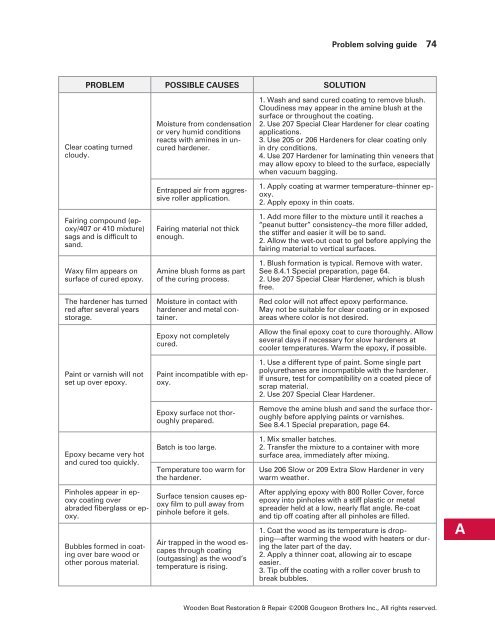Wooden Boat Restoration Repair - WEST SYSTEM Epoxy
Wooden Boat Restoration Repair - WEST SYSTEM Epoxy
Wooden Boat Restoration Repair - WEST SYSTEM Epoxy
You also want an ePaper? Increase the reach of your titles
YUMPU automatically turns print PDFs into web optimized ePapers that Google loves.
PROBLEM POSSIBLE CAUSES SOLUTION<br />
Clear coating turned<br />
cloudy.<br />
Fairing compound (epoxy/407<br />
or 410 mixture)<br />
sags and is difficult to<br />
sand.<br />
Waxy film appears on<br />
surface of cured epoxy.<br />
The hardener has turned<br />
red after several years<br />
storage.<br />
Paint or varnish will not<br />
set up over epoxy.<br />
<strong>Epoxy</strong> became very hot<br />
and cured too quickly.<br />
Pinholes appear in epoxy<br />
coating over<br />
abraded fiberglass or epoxy.<br />
Bubbles formed in coating<br />
over bare wood or<br />
other porous material.<br />
Moisture from condensation<br />
or very humid conditions<br />
reacts with amines in uncured<br />
hardener.<br />
Entrapped air from aggressive<br />
roller application.<br />
Fairing material not thick<br />
enough.<br />
Amine blush forms as part<br />
of the curing process.<br />
Moisture in contact with<br />
hardener and metal container.<br />
<strong>Epoxy</strong> not completely<br />
cured.<br />
Paint incompatible with epoxy.<br />
<strong>Epoxy</strong> surface not thoroughly<br />
prepared.<br />
Batch is too large.<br />
Temperature too warm for<br />
the hardener.<br />
Surface tension causes epoxy<br />
film to pull away from<br />
pinhole before it gels.<br />
Air trapped in the wood escapes<br />
through coating<br />
(outgassing) as the wood’s<br />
temperature is rising.<br />
Problem solving guide 74<br />
1. Wash and sand cured coating to remove blush.<br />
Cloudiness may appear in the amine blush at the<br />
surface or throughout the coating.<br />
2. Use 207 Special Clear Hardener for clear coating<br />
applications.<br />
3. Use 205 or 206 Hardeners for clear coating only<br />
in dry conditions.<br />
4. Use 207 Hardener for laminating thin veneers that<br />
may allow epoxy to bleed to the surface, especially<br />
when vacuum bagging.<br />
1. Apply coating at warmer temperature–thinner epoxy.<br />
2. Apply epoxy in thin coats.<br />
1. Add more filler to the mixture until it reaches a<br />
“peanut butter” consistency–the more filler added,<br />
the stiffer and easier it will be to sand.<br />
2. Allow the wet-out coat to gel before applying the<br />
fairing material to vertical surfaces.<br />
1. Blush formation is typical. Remove with water.<br />
See 8.4.1 Special preparation, page 64.<br />
2. Use 207 Special Clear Hardener, which is blush<br />
free.<br />
Red color will not affect epoxy performance.<br />
May not be suitable for clear coating or in exposed<br />
areas where color is not desired.<br />
Allow the final epoxy coat to cure thoroughly. Allow<br />
several days if necessary for slow hardeners at<br />
cooler temperatures. Warm the epoxy, if possible.<br />
1. Use a different type of paint. Some single part<br />
polyurethanes are incompatible with the hardener.<br />
If unsure, test for compatibility on a coated piece of<br />
scrap material.<br />
2. Use 207 Special Clear Hardener.<br />
Remove the amine blush and sand the surface thoroughly<br />
before applying paints or varnishes.<br />
See 8.4.1 Special preparation, page 64.<br />
1. Mix smaller batches.<br />
2. Transfer the mixture to a container with more<br />
surface area, immediately after mixing.<br />
Use 206 Slow or 209 Extra Slow Hardener in very<br />
warm weather.<br />
After applying epoxy with 800 Roller Cover, force<br />
epoxy into pinholes with a stiff plastic or metal<br />
spreader held at a low, nearly flat angle. Re-coat<br />
and tip off coating after all pinholes are filled.<br />
1. Coat the wood as its temperature is dropping—after<br />
warming the wood with heaters or during<br />
the later part of the day.<br />
2. Apply a thinner coat, allowing air to escape<br />
easier.<br />
3. Tip off the coating with a roller cover brush to<br />
break bubbles.<br />
<strong>Wooden</strong> <strong>Boat</strong> <strong>Restoration</strong> & <strong>Repair</strong> ©2008 Gougeon Brothers Inc., All rights reserved.<br />
A
















